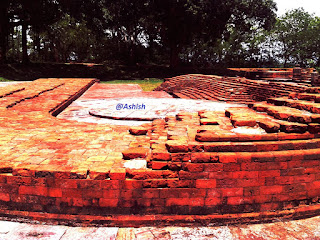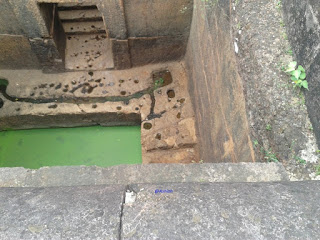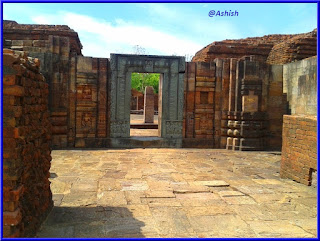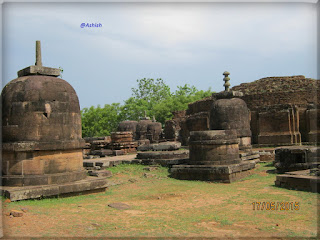When Cuttack ends and Jajpur starts, you will find so many mountains of Eastern Ghats touching the horizons.
Based on the signboards by Odisha tourism department and with the help of the local people, I reached the spot “Langudi Hill” withing 1Hr and 45Mins from Bhubaneswar.
Some details from Wiki:
Pusphagiri (Also Puspagiri Mahavihara) (Oriya/Odia: ପୁଷ୍ପଗିରି), one of the earliest buddhist mahavihara spread across Cuttack and Jajpur district, Odisha (ancient Kalinga) in 3rd century AD, flourished until the 11th century in India. Today, its ruins lie atop the Langudi hills, low hills about 90 km from the Mahanadi delta, in the Jajpur and Cuttack district in Odisha. The actual mahavihara campus, spread across three hilltops, contained several stupas, monasteries, temples, and sculptures in the architectural style of the Gupta period. The Kelua river, a tributary of the Brahmani river of Odisha, which flows to the north east of Langudi hills, provided a picturesque background for the mahavihara. The entire mahavihara is distributed across three campuses on top of the three adjoining hills, Lalitgiri, Ratnagiri, and Udayagiri.
http://en.wikipedia.org/wiki/Puphagiri
Structures related to Hinajana(Hinayana), Mahajana(Mahayana), Vajrajana(Vajrayana):
As told by the guide, after the Mahaparinirvana (dehatyaga/demise) of Lord Buddha, the disciples took the hair, nail, tooth of Buddha and started worshipping by keeping it inside a pot in the big stupas. That time, properly sculptured stupas were not available.
When Mahayana concept came into pitcure, the previous version of Buddhism got its name as Hinayana. “Hina” means “Less Value”. The Mahayana followers built proper stupas and Buddha statues.
As Hinayana was giving a negative meaning, it was gradually called as Teravada.
Then the time came when some followers of Mahayana started following Tantrisim of Sakta cult along with Mahayana.
So a new cult was formed as Vajrayana. The Vajrayana followers started making Buddha statues along with Yogini (For Yogini, Please refer my blog “http://www.bcmtouring.com/forums/th…ini-yogini-temple-hypaethral-structure.62568/“) statues and started worshiping them.
Constructions during Hinayana times…(Constructed During 2nd Century BC)…
Maha Stupa: It was excavated at the center by ASI department, but they found only some broken pieces of clay pots, lamps etc…
Stone inscription written in Pali…
Monastery area which is slightly excavated…(Constructed During 8th to 9th Century AD)…
Rock-cut stupas…During Mahayana and Vajrayana times…(Constructed During 2nd to 3rd Century AD)…
During Mahayana there were no Yogini images. These were added when some Mahayana followers started practising Vajrayana (Buddhist Tantrism).
Lalitgiri (Oriya: ଲଳିତଗିରି) (also known as Naltigiri) is a major Buddhist complex in the Indian state of Odisha comprising major stupas, ‘esoteric’ Buddha images, and monasteries (viharas), one of the oldest sites in the region. Together with the Ratnagiri and Udayagiri sites, Lalitgiri is part of Puspagiri University located on top of hills of the same names. The three complexes are known as the “Diamond Triangle”. Significant finds at this complex include Buddha’s relics. Tantric Buddhism was practiced at this site.
http://en.wikipedia.org/wiki/Lalitgiri
“Chaityagriha Stupa Complex”…(Constructed During 1st Century BC to 7th Century AD)…
Monastery No.3… (Constructed During 4th to 8th Century AD)…
<<——————————————————————————————————————->>
Some details from Wiki.
Udayagiri (ଉଦୟଗିରି ) is the largest Buddhist complex in the Indian state of Odisha. It is composed of major stupas and monasteries (viharas). Together with the nearby complexes of Lalitgiri and Ratnagiri, it is part of Puspagiri University. The heritage sites are also known collectively as the “Diamond Triangle” of the “Ratnagiri-Udayagiri-Lalitgiri” complex. Per epigraphical artifacts found at the site, its historical name was “Madhavapura Mahavihara.” This Buddhist complex, preceded by the Ratnagiri and Lalitgiri sites, with their monasteries, is believed to have been active between the 7th and the 12th centuries. Chinese traveller Hiuen Tsang, who visited these sites in the 7th century, noted that it was the site of Pushpagiri University.
http://en.wikipedia.org/wiki/Udayagiri,_Odisha
<<——————————————————————————————————————->>
Some details from Wiki…
Ratnagiri (Oriya: ରତ୍ନଗିରି) was once the site of a mahavihara, or major Buddhist monastery, in the Brahmani and Birupa river valley in Jajpur district of Odisha, India. It was part of the Puspagiri University, together with Lalitgiri and Udayagiri.
http://en.wikipedia.org/wiki/Ratnagiri,_Odisha
Ratnagiri is currently one of the huge Buddhist sites in Odisha.
It has numerous votive stupas, monasteries, temples and large Buddha statues.
Each votive stupa contains a Yogini inside it. But Yogini cult is part of Sakta cult (Refer this on the Yogini temple: http://www.bcmtouring.com/forums/th…ini-yogini-temple-hypaethral-structure.62568/). As the legends tell, when Mahayana buddhists started following Tantrism of Sakta cult, then Vajrayana buddism was formed.
Try the 4 places when at Bhubaneswar.
Start at 7AM. 1Hr 45 Mins to Langudi from Bhubaneswar by taxi. Spend 30mins there.
Then 30mins journey to Lalitagiri. Spend 1hr there.
Then 30mins journey to Udayagiri. Spend 30mins there.
Then 10mins journey to Ratnagiri. Spend 1hr there and the nearby Museum.
While returning, take lunch in the Dhabas at Chandikhol.






















































